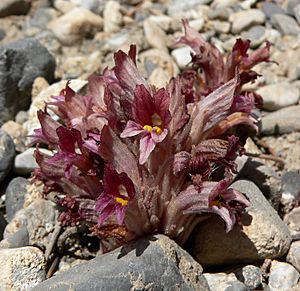Flat-top broomrape facts for kids
Quick facts for kids Flat-top broomrape |
|
|---|---|
 |
|
| Conservation status | |
| Scientific classification | |
| Genus: |
Orobanche
|
| Species: |
corymbosa
|
Orobanche corymbosa, also known as flat-top broomrape, is a special kind of plant found in western North America. It's a parasite, which means it grows by attaching itself to the roots of other plants, usually sagebrush. Think of it like a plant that "borrows" all its food from another plant!
What is Flat-Top Broomrape?
This plant gets its common name, flat-top broomrape, from how its flowers grow. It's part of a group of plants called broomrapes. Unlike most plants you know, Orobanche corymbosa doesn't have green leaves. This is because it doesn't need to make its own food using sunlight, like other plants do. Instead, it gets all its nutrients from its host plant.
How Does it Grow?
The flat-top broomrape grows a cluster of thick stems that can be whitish or yellowish, sometimes even a bit purple. These stems can grow up to 17 centimetres (6.7 in) tall. They have tiny hairs and a swollen base where they connect to strong roots. These roots are what attach to the sagebrush, allowing the broomrape to take in all the food and water it needs.
What Does it Look Like?
The flowers of the flat-top broomrape grow in a wide, flat cluster at the top of the stem. Each flower is shaped like a tube and is about 2 centimetres (0.79 in) or 3 centimetres (1.2 in) long. They are covered in tiny, sticky hairs and often have dark veins, making them look pink or purple. These unique flowers help identify this interesting parasitic plant.


